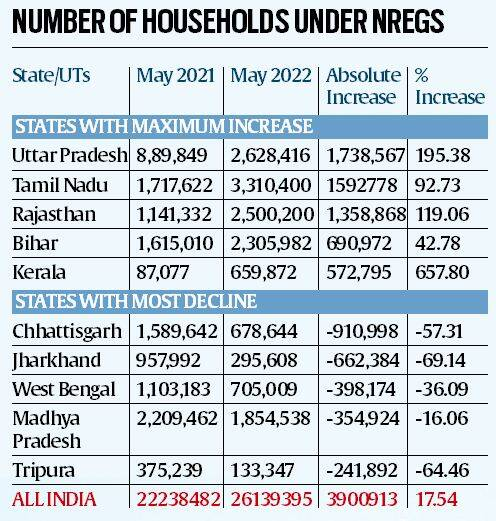Governance
Increase in NREGS demand
- 29 Jun 2022
- 7 min read
For Prelims: NREGS (National Rural Employment Guarantee Scheme)
For Mains: Working of NREGS, its challenges and the way forward
Why in News?
In May 2022, 2.61 crore households worked under the NREGS (National Rural Employment Guarantee Scheme), which is 17.39% more than in the same month last year.
What are the Key Findings?
- There was a rise in demand for NREGS after the dip in April. In April 2022, 1.86 crore families availed the NREGS, which is 12.27% lower than the number recorded in April last year.
- The number of households that availed the NREGS is lower than May 2020, when the demand sharply rose to 3.30 crore as migrant workers returned to their villages in wake of lockdown during the first wave of Covid-19.
- But it is higher than the 2.10 crore figure recorded in May 2019 (pre-pandemic times).
- In terms of states, Uttar Pradesh saw the maximum increase in terms of the absolute increase in the number of families availing the NREGS, followed by Tamil Nadu.
- Whereas, the maximum decline was recorded in Chhattisgarh followed by Jharkhand.
What is NREGS?
- The Mahatma Gandhi National Rural Employment Guarantee Act (MGNREGA), also known as Mahatma Gandhi National Rural Employment Guarantee Scheme (MNREGS) is legislation enacted on 25th August, 2005.
- It provides a legal guarantee for one hundred days of employment in every financial year to adult members of any rural household willing to do public work-related unskilled manual work at the statutory minimum wage.
- The Ministry of Rural Development (MRD) is monitoring the entire implementation of this scheme in association with state governments.
- This act was introduced with an aim of improving the purchasing power of the rural people, primarily semi or unskilled work to people living below poverty line in rural India. It attempts to bridge the gap between the rich and poor in the country.
- According to the law roughly one-third of the stipulated work force must be women.
- The registered person can submit an application for work in writing (for at least fourteen days of continuous work) either to Panchayat or to Programme Officer.
- Employment will be provided within a radius of 5 km. And if it is beyond 5 km, an extra wage will be paid.
- A majority of the works that are notified under NREGS are related to agricultural and allied activities, besides the works that facilitate rural sanitation projects in a major way.
- NREGS is a demand-driven wage employment programme and resource transfer from the Centre to the states is based on the demand for employment in each state.
- It provides a legal guarantee for wage employment by providing allowances and compensation both in cases of failure to provide work on demand and delays in payment of wages for work undertaken.
- In May 2021, the Ministry of Rural Development launched the National Mobile Monitoring Software (NMMS) app, a new application meant for “improving citizen oversight and increasing transparency” in National Rural Employment Guarantee Act (NREGA) works.
What have been the Outcomes of NREGS?
- In the past 15 years, it has created more than 31 billion person-days of employment.
- In the last 15 years, the government has invested more than Rs 6.4 lakh crore in this demand-driven programme.
- In the rural sections of the nation, more than 30 million water conservation-related assets have been developed since 2006.
What are the Challenges?
- Low wage rates: NREGS wages are currently around Rs. 180 per day, which is far below the market rate. For almost a decade, the wages have been adjusted only for inflation, ignoring the average wage rate for the same kind of work. And right now, they have fallen below the minimum wage rate in 23 states, leading to a dip in participation.
- Late Payments: Another issue is that despite the scheme mandating that workers be paid within 15 days; these people often don’t get paid at all. The past few financial years have opened with a large balance of wage arrears- nearly Rs. 10,000 crores in 2019–20. According to the government’s portal, over 30% of wage requests have been pending since October 2019.
- Corruption: The biggest issue with the scheme is that even if the funding allocation increases, it’s very hard to root out corrupt middlemen from the system.
- Wasteful work: Most officials simply offer pointless busy work that adds no value to the agricultural infrastructure in the country. It’s like asking people to dig holes and fill them up in order to tick a box.
Way Forward
- The government could look at linking the wages to a consumption-based index- one that is revised annually, the idea is that this way the wage workers can be compensated adequately based on their consumption needs. This may be a better approach.
- Need to leverage technology to tackle corruption and reduce the issue of late payments through efficient management of resources.







